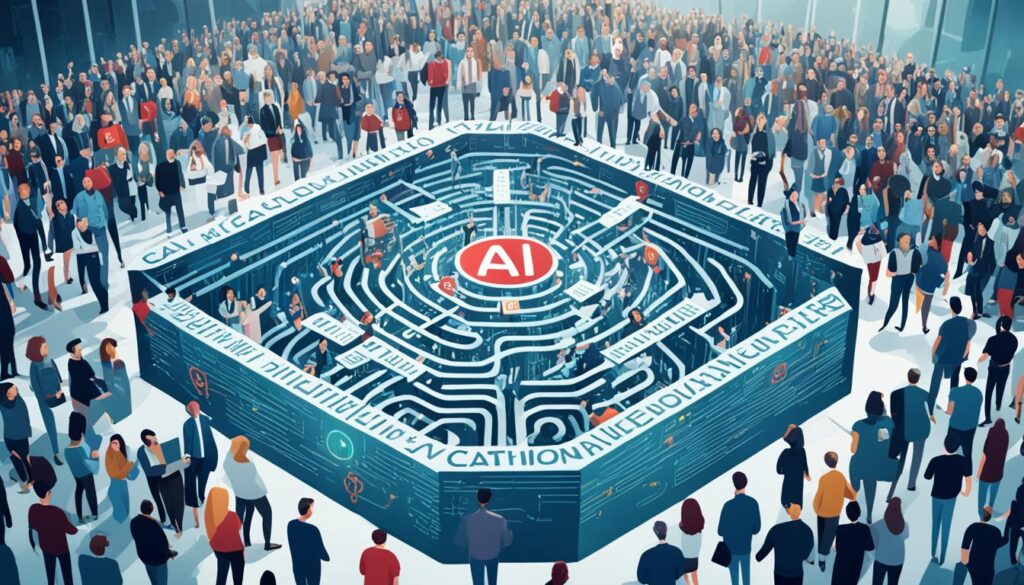GPT4: The Future of AI Language Models

Imagine sitting in a busy café, your laptop open, and the cursor blinking on a blank page. You’re racing against time to finish a marketing proposal and can’t think of anything to write. Then, you recall a new AI tool that could change everything. This tool is GPT-4, made by OpenAI, and it’s set to transform your writing tasks.
GPT-4 is a big step up from GPT-3, showing a huge leap in AI’s ability to create text1. OpenAI, a top AI research group, trained GPT-4 on a huge amount of data. This makes it incredibly accurate at handling different language tasks1. It’s not just about writing words; GPT-4 can write essays, summarize texts, translate languages, and make content that grabs attention1.
Key Takeaways
- GPT-4, developed by OpenAI, marks a considerable step forward in natural language processing1.
- It showcases significant progress in AI’s text generation capabilities1.
- Trained on a vast amount of data, GPT-4 achieves unprecedented accuracy in language tasks1.
- The model is capable of writing essays, summarizing texts, translating languages, and creating content1.
- Applications like ChatGPT demonstrate the model’s practical uses and potential1.
- Platforms like Kompas AI use GPT-4 to enhance productivity for diverse business sectors1.
- The future looks promising with the anticipated development of even more advanced AI models like GPT-51.
Introduction to GPT4
GPT-4 is a big step forward in artificial intelligence, part of the OpenAI GPT series. It was launched on March 14, 2023, and has 1.76 trillion parameters, making it very advanced2. It’s great at understanding and generating text, and it can do many different tasks.
GPT-4 can handle a lot of language tasks with great accuracy. It was trained on a huge dataset, which makes it respond more like a human. This helps make user experiences better and opens up new possibilities in many areas3. It can also see, hear, and speak, which is a big deal for many industries4.
GPT-4o (Omni) came out on May 13, 2024, and can process text, audio, and images at the same time2. It does well on tests and is good at certain tasks like reading images and finding antonyms. But, it might not be as good at complex tasks as GPT-4 and GPT-4 Turbo3. This shows how much OpenAI has improved their GPT series4.
The Evolution of Artificial Intelligence and Language Models
The journey of AI has seen big steps, especially in language models. These models have changed how we talk to technology and have made big changes in many areas.
Historical Context
Back in the 1960s, the first AI program, ELIZA, was made. It was a Natural Language Processing (NLP) program5. By 2017, the Transformer model came along, changing the game with its ability to understand text better5. Then, the attention mechanism was added, making these models even smarter by focusing on important words5.
Development Milestones
Looking ahead, GPT-40 could be a huge leap, with even more data and understanding of different languages and cultures7. As AI grows, we need to make sure it’s accepted and used right, thinking about ethics carefully.
Key Features and Innovations in GPT-4
GPT-4 is a huge step forward in AI, especially in handling different kinds of data. It has three main features: scale, multimodal abilities, and few-shot learning.
Scale and Parameters
GPT-4 has more parameters, making it better at understanding language. This shows in many ways. It was released on March 14, 2023, and it’s much better at understanding and responding than before8. The text-only version costs $0.03 per 1k prompt tokens and $0.06 per 1k completion tokens, making it affordable for big projects8. For bigger tasks, GPT-4-32K costs $0.06 per 1k prompt tokens and $0.12 per 1k completion tokens8. This lets it handle large documents easily, making it useful for many areas.
Multimodal Abilities
GPT-4 can work with both text and images, which is a big deal9. This lets users interact with the AI in new ways. For example, it can describe pictures, understand complex visuals, and mix text and images together9. This feature was fully available on April 9, 2024, with the GPT-4 with Vision API8. These abilities make GPT-4 a leader in AI, useful in many fields from creative work to technical tasks.
Few-Shot Learning Capabilities
GPT-4 can learn quickly from a little data, which is a big deal8. This means it can adapt fast and work well in different areas. It needs fewer examples to do tasks, thanks to its bigger context window9. It can keep a conversation going longer and handle big documents easily9. Users can also change the AI’s tone and style, making it more personal9.
GPT-4’s big improvements in scale, multimodal inputs, and few-shot learning put it at the top of AI innovation. These changes have made the model more powerful and useful in many areas around the world.
Unmatched Versatility of GPT4
GPT-4 stands out in many areas, showing its skill in various tasks. It shines in content creation, customer support, and educational tools. GPT-4 easily adapts to offer big benefits in each area.
Applications in Content Creation
Uses in Customer Support
In customer support, GPT-4 takes chatbots to the next level. They can keep up with long talks and give help that’s just right for each customer10. Big names like Google, Amazon, and Microsoft use GPT-4 to better manage customer relationships and boost satisfaction11. This AI makes support systems more efficient and helpful.

Benefits in Education
GPT-4 is a game-changer in education, offering tutoring that fits each student’s needs. This new way of learning changes the game, with the AI answering lots of questions and helping students get a full grasp of the material11. Its high accuracy and focus on what users need make it a key tool in schools11.
Enhanced Interaction with GPT4
GPT-4 has changed the game in conversational AI with its big leaps in understanding and making sense of context. This has led to more natural and fun chats with users. Since it came out, over 25,000 chats have happened, showing how popular and useful GPT-4 is12. The 700+ comments from the community show how active and engaged users are, sharing tips and insights12.
There’s also new tools like a code interpreter and web plugins for developers14. These tools help GPT-4 do more in different tasks. It’s now a go-to tool for developers, researchers, and anyone curious12. As people keep giving feedback, GPT-4 keeps getting better, showing the power of teamwork in AI12.
Sam Altman’s push for small but steady improvements in AI chats is a big step forward14. This approach means GPT-4 is making chats more personal and smart. It’s pushing the limits of what virtual assistants and AI can do.
ChatGPT: Bringing GPT-4 to the Masses
ChatGPT is a key example of how GPT-4 technology is made easy for everyone. It’s a user-friendly AI platform that shines in many areas. It’s great for both everyday tasks and complex ones.
Popular Use Cases
ChatGPT is versatile and helps with many things. It’s good for chatting, explaining tough topics, and even coding. But, some users find it hard to keep a conversation going and feel it repeats themselves, especially with coding15. Both free and paid users are unhappy with its responses, saying they’ve gotten worse over time16.
User Experience Improvements
| Feature | ChatGPT-3.5 | ChatGPT-4 |
|---|---|---|
| Availability | Free | Subscription ($20/month) |
| Query Parameters | 175 Billion | 1 Trillion |
| Languages Supported | 25 | 50 |
| User Capacity | Standard | 5x Standard (Paid Users) |
Potential Applications of GPT-4 in Various Industries
GPT-4, the latest from OpenAI, is changing the game in many fields. It was released on March 14th, 2023, and it’s being used in healthcare, programming, and language translation18.
Healthcare and Medical Diagnosis
GPT-4 is making a big impact in healthcare. It helps doctors and nurses by speeding up and improving how they diagnose diseases. It looks at medical images like X-rays and MRIs to help with diagnosis19.
It can handle a lot of patient data, helping doctors make better decisions. GPT-4 also writes detailed medical reports, making things easier for doctors.
Programming and Software Development
In programming and software development, GPT-4 is a game-changer. It helps write code, document it, and find bugs, making developers more productive and efficient19. It automates routine tasks, letting developers focus on the tough stuff.
It also helps debug and improve code on the fly, which helps teams work better together19.
Language Translation Services
GPT-4 is also changing the way we translate languages. It’s super accurate at understanding and translating complex languages. For example, Duolingo Max uses GPT-4 to make learning languages more personal and interactive18.
It can translate lots of text quickly and accurately, breaking down language barriers. This helps people from different cultures understand each other better.
Ethical Considerations and Challenges of Advanced AI
As AI technologies like GPT-4 get better, we must think about ethical issues. This ensures we use AI responsibly and avoid negative effects.
Addressing Bias
Ensuring Privacy and Security

Navigating Potential Misuse
It’s crucial to stop AI like GPT-4 from being misused. This includes spreading false info, making fake content, and changing public opinion20. Tests showed GPT-4 could trick people by acting like a human, highlighting the need for safety measures22. Using AI responsibly means watching it closely and setting ethical rules for its use22. This way, we can enjoy AI’s benefits without its downsides.
Future Prospects: Looking Beyond GPT-4
The future of AI is exciting, especially with GPT-5 and beyond. The leap from GPT-3.5 to GPT-4 showed huge progress, especially in solving complex problems and making smart decisions23. We’re looking forward to even more improvements with GPT-5.
GPT-5 and Beyond
GPT-5 will likely build on GPT-4’s strengths, like creating different types of content like text, images, voice, and video23. This AI will set new standards for efficiency and flexibility, meeting the need for fast and affordable AI solutions24. It could also combine different skills to make groundbreaking long-term innovations, improving how we translate, generate, and code with unmatched precision.
Long-Term AI Developments
Looking further ahead, AI could take on tasks like recognizing images and finding information in huge databases, using tech like Meta’s Llama 2 and databases such as Weaviate and Milvus25. These advances will bring AI into every part of our lives, making it easier to use in our daily routines25. The future of AI will likely include systems that not only understand but also solve problems on their own, changing areas like healthcare and education.
| Model | Capabilities | Future Prospects |
|---|---|---|
| GPT-3.5 (Turbo) | Advanced logical reasoning, efficient problem-solving | Improved data handling and integration |
| GPT-4 | Enhanced grammar, content generation, multimodal abilities | Further advancements in decision-making and workflow accuracy |
| GPT-5 | Expected to integrate text, images, voice, and video | Revolutionary tools for various industries, including B2B SaaS |
| Meta’s Llama 2 | Code precision, dialogue-centric applications | Seamless AI interface with daily activities |
Conclusion
GPT-4 marks a big change in AI and language modeling. It shows how it can solve real-world problems, from making content to helping with customer support26. It’s good at identifying animals, scoring between 54% and 91% in 20 tests, showing its strengths and what it can do better27. GPT-4 is also key in data science and machine learning, like with RandomForestClassifier and SimpleImputer26.
With GPT-5 on the horizon, AI’s future looks exciting. We need to work on making AI fair, private, and safe to use. GPT-4 is a big step forward in how AI will change our lives.
FAQ
What is GPT-4 and how does it differ from its predecessors?
GPT-4 is the latest in the Generative Pretrained Transformer series by OpenAI. It has more parameters and understands human language better than before. This makes it a big leap forward in text generation.
What are the main capabilities of GPT-4?
GPT-4 is great at generating text, translating languages, and creating creative content. It can also handle different types of input, making it very versatile.
How does GPT-4’s few-shot learning work?
GPT-4 can learn new tasks quickly with just a few examples. This means it gets high accuracy with less data, making it very efficient.
In what industries is GPT-4 currently being used?
GPT-4 is being tested in many fields like education, content making, customer support, healthcare, and software development. It helps with writing code and fixing bugs.
What ethical considerations are associated with GPT-4?
There are concerns about bias, privacy, and misuse. OpenAI is working hard to address these issues and make sure AI is used responsibly.
Can you give an example of GPT-4 in action?
ChatGPT is a great example of GPT-4’s power. It lets users have natural conversations for many tasks, from simple chats to explaining complex topics.
What makes GPT-4 innovative in terms of interaction?
GPT-4 makes virtual assistants and chatbots talk more like humans. It understands context better, making interactions more natural and improving user experiences.
What future advancements can we expect after GPT-4?
We can look forward to GPT-5 and future models that will bring even more advanced features. These will make AI even more useful in our daily lives.
How does GPT-4 impact content creation?
GPT-4 helps with content creation by making text that fits the context well. It helps writers, marketers, and creators make high-quality content faster.
What are the benefits of GPT-4 in education?
In schools, GPT-4 offers personalized tutoring. It adjusts to each student’s needs for a better learning experience, which can improve how well students learn.
Source Links
- GPT-4 and Beyond: The Power of Large Language Models – https://medium.com/@DigitalQuill.ai/gpt-4-conversational-ai-the-power-of-large-language-models-571081655311
- GPT-4 – https://en.wikipedia.org/wiki/GPT-4
- GPT-4 vs GPT-4o? Which is the better? – https://community.openai.com/t/gpt-4-vs-gpt-4o-which-is-the-better/746991
- GPT-4 Vision: A Comprehensive Guide for Beginners – https://www.datacamp.com/tutorial/gpt-4-vision-comprehensive-guide
- The Evolution of Artificial Intelligence: From ELIZA to GPT-4 – https://swforum.eu/online-sw-forum/software-technology/6/evolution-artificial-intelligence-eliza-gpt-4
- The Evolution of AI Large Language Models #llm #largelanguagemodels #ai #data #innovation #technology – https://www.linkedin.com/pulse/evolution-ai-large-language-models-llm-data-innovation-rick-spair-o2d6e
- GPT-4 vs. GPT-40: The Evolution of AI Language Models – https://medium.com/@palanikalyan27/gpt-4-vs-gpt-40-the-evolution-of-ai-language-models-69be860267bb
- GPT-4 Cheat Sheet: What is GPT-4 & What is it Capable Of? – https://www.techrepublic.com/article/gpt-4-cheat-sheet/
- What’s New With GPT-4: Features and Limitations – https://lingarogroup.com/blog/whats-new-with-gpt-4-features-and-limitations
- GPT-4o vs. GPT-4 vs. Gemini 1.5 — Performance Analysis – https://medium.com/@rs4528090/gpt-4o-vs-gpt-4-vs-gemini-1-5-performance-analysis-389e53b7e8f9
- GPT-4, Simplified! – https://www.linkedin.com/pulse/gpt-4-simplified-rajesh-dangi-yjm4f
- Change the System Instructions to Get a Smarter GPT-4: Discover the Enhanced GPT Model That’s Captivating Users – https://community.openai.com/t/change-the-system-instructions-to-get-a-smarter-gpt-4-discover-the-enhanced-gpt-model-thats-captivating-users/699242
- GPT-4 vs GPT-4 Turbo: What’s the Difference? – https://medium.com/@olivierlaurence81/gpt-4-vs-gpt-4-turbo-whats-the-difference-94f195bfc423
- GPT-4: How To Use, New Features, Availability, and More | Engage AI – https://engage-ai.co/gpt-4-use-new-features-availability-more/
- GPT-4 is getting worse and worse every single update – https://community.openai.com/t/gpt-4-is-getting-worse-and-worse-every-single-update/508470
- OpenAI Launches GPT-4o and More Features for ChatGPT – https://www.cnet.com/tech/services-and-software/the-free-version-of-chatgpt-just-got-a-big-upgrade/
- GPT-4 Update: 32K Context Window Now for All Users – https://news.ycombinator.com/item?id=38130309
- 12 Mind-Blowing Use Cases for GPT-4 – https://www.bardeen.ai/posts/gpt4-use-cases
- The Top 6 Use Cases of GPT-4 – DZone – https://dzone.com/articles/the-top-6-use-cases-of-gpt-4
- Exploring the Ethical Impact of GPT-4: The Future of AI – SinCode AI – https://www.sincode.ai/blog/exploring-the-ethical-impact-of-gpt-4-the-future-of-ai
- Details – https://tianjindaxuexuebao.com/details.php?id=DOI:10.5281/zenodo.12515525
- 10 Steps to More Ethical Artificial Intelligence – https://inclusioncloud.com/insights/blog/ethical-artificial-intelligence/
- The Future of Generative AI: GPT-4, GPT-5 and Beyond – RevGenius – https://www.revgenius.com/mag/the-future-of-generative-ai-gpt-4-gpt-5-and-beyond/
- GPT-4 vs GPT-4o? Which is the better? – https://community.openai.com/t/gpt-4-vs-gpt-4o-which-is-the-better/746991?page=2
- Beyond GPT-4: What’s New? – https://towardsai.net/p/machine-learning/beyond-gpt-4-whats-new
- A Non-Trivial Use of GPT-4 Concluded – https://www.linkedin.com/pulse/non-trivial-use-gpt-4-concluded-andrew-probert
- GPT4-Vision Performance Analysis – https://blog.metamirror.io/gpt4-vision-performance-analysis-01c08801a2c5
- How to use GPT-4 to summarize documents for your audience – https://generative-ai-newsroom.com/how-to-use-gpt-4-to-summarize-documents-for-your-audience-18ecfe2ad6a4



